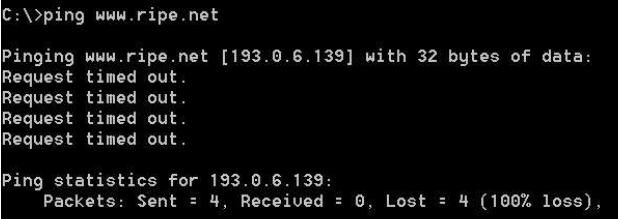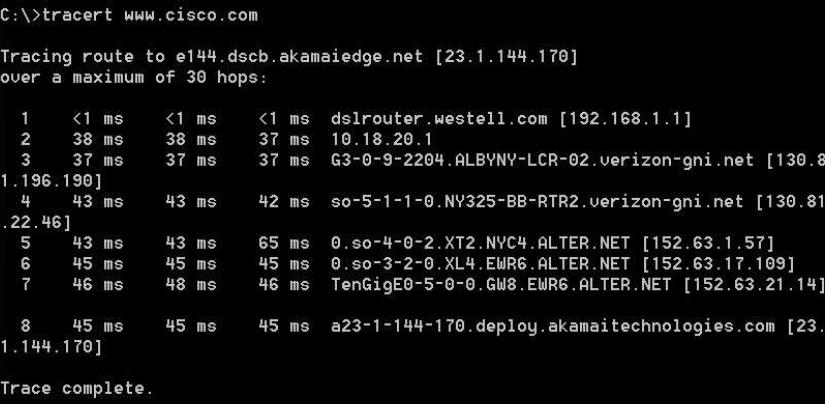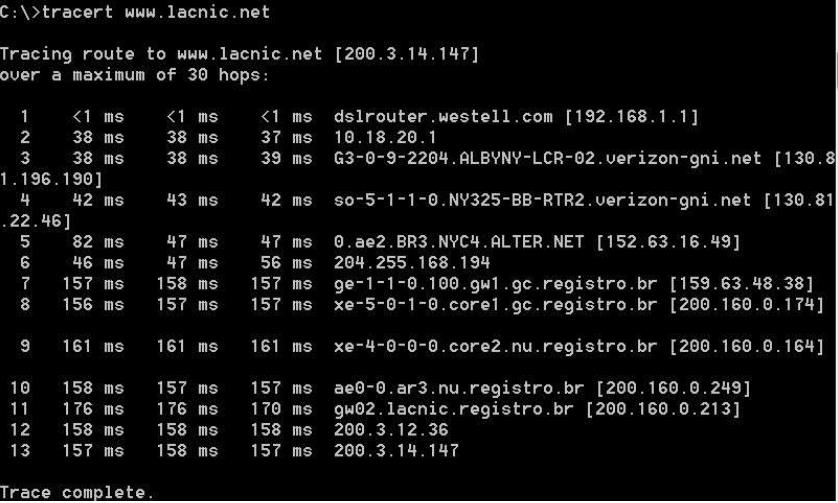Internet traffic starts home and travels through the home router hop
for
Embedded Systems and
Lab Workshop/Lab 1 Embedded Systems and the Internet of Things EEE_6_ESI
Lab 1
Background
Route tracing software is used to list the networks that data must traverse from the user's originating end device to a distant destination network.
The traceroute (or tracert) tool is often used for network troubleshooting. By showing a list of routers traversed, it allows the user to identify the path taken to reach a particular destination on the network or across internetworks. Each router represents a point where one network connects to another network and through which the data packet was forwarded. The number of routers is known as the number of "hops" the data travelled from source to destination.
The displayed list can help identify data flow problems when trying to access a service such as a website. It can also be useful when performing tasks such as downloading data. If there are multiple websites (mirrors) available for the same data file, one can trace each mirror to get a good idea of which mirror would be the fastest to use.
Other tools, such as VisualRoute™, are proprietary programs that provide extra information. VisualRoute uses available online information to graphically display the route.
This lab assumes the installation of VisualRoute. If the computer you are using does not have VisualRoute installed, you can download the program using the following link:
Lab Work
A1: Test Network Connectivity Using Ping Determine whether the remote server is reachable.
3
Lab Workshop/Lab 1 Embedded Systems and the Internet of Things EEE_6_ESI
Four pings were sent and a reply was received from each ping. Because each ping was responded to, there was 0% packet loss. On average, it took 54 ms (54 milliseconds) for the packets to cross the network. A millisecond is 1/1,000th of a second. Streaming video and online games are two applications that suffer when there is packet loss, or a slow network connection. A more accurate determination of Internet connection speed can be determined by sending 100 pings, instead of the default 4. Here is how to do that:
4
Lab Workshop/Lab 1 Embedded Systems and the Internet of Things EEE_6_ESI
For South America:
C:\> ping
What is interesting about the pings that were sent to the European website? Answer briefly in your logbook.
A2: Trace a Route to a Remote Server Using Tracert
Determine what route across the Internet traffic takes to the remote server.a)Right-click the title bar of the Command Prompt window and choose Edit > Select All.
6
e)Choose File > Save As and save the Notepad file to your desktop as tracert1.txt.
3.Run tracert for each destination website and save the output in sequentially numbered files.
Because computers talk in numbers, rather than words, routers are uniquely identified using IP addresses (numbers with the format x.x.x.x for IPv4 addresses). The tracert tool shows you what path through the network a packet of information takes to reach its final destination. The tracert tool also gives you an idea of how fast traffic is going on each segment of the network. Three packets are sent to each router in the path, and the return time is measured in milliseconds. Now use this information to analyze the tracert results to www.cisco.com. Below is the entire traceroute:
In the example output shown above, the tracert packets travel from the source PC to the local router default gateway (hop 1: 192.168.1.1) to the ISPs Point of Presence (POP) router (hop 2: 10.18.20.1). Every ISP has numerous POP routers. These POP routers are at the edge of the ISP’s network and are the means by which customers connect to the Internet. The packets travel along the Verizon network for two hops and then jump to a router that belongs to alter.net. This could mean that the packets have travelled to another ISP. This is significant because sometimes there is packet loss in the transition between ISPs, or sometimes one ISP is slower than another.
There is an Internet tool known as Whois. The Whois tool allows us to determine who owns a domain name.
b)What happens in hop 10 to the amount of time it takes for a packet to travel between Washington D.C. and Paris, as compared with hops 1-9?
c)What happens in hop 18? Do a Whois lookup on 168.209.201.74 using the Whois tool. Who owns this network?
6.Type tracert
1.Use to trace the
www.cisco.com
Capture and save the output in swer the following questions in your logbook.a)How is the traceroute different when going to www.cisco.com from the
command prompt (see A2) rather than from the online website? (Your results may vary depending upon where you are located geographically, and which ISP is providing connectivity to you.)
b)Compare the tracert from A1 that goes to Africa with the tracert that goes to Africa from the web interface. What difference do you notice?A4: Compare Traceroute Results
Compare the traceroute results to www.cisco.com from A2 and A3. Then answer the following questions in your logbook.
Lab Workshop/Lab 1 Embedded Systems and the Internet of Things EEE_6_ESI
Reflection
Background/Scenario
Many devices have sensors in them that affect the operation of processes or generate data to assist governments and businesses. Use your imagination to think of devices that could be made more useful if they contained intelligent sensors.
a)Describe the object that you selected.
b)What kind of data would sensors in this object gather?
Advantages and Disadvantages of IoT Devices
Learning Objectives
Brainstorm the pros and cons of sensors.1.Answer the following questions in your logbook.
a)Describe some of the advantages for including sensors in parking spaces in a municipal parking garage?




